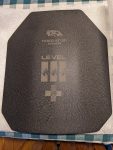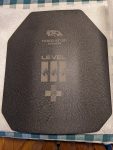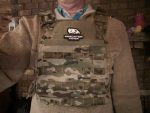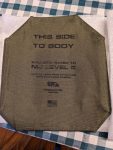Predator Armor Plate Carrier and Plates, by Thomas Christianson


I recently had the chance to test the Predator Armor Minuteman Plate Carrier as well as a couple of Predator Armor steel plates. I found the 500D Cordura material from which the plate carrier is made to be robust, stain and odor resistant, comfortable to wear. It included 6 rows of MOLLE style webbing. It cost $160 at the time of this writing from www.predatorarmor.com.
One of the plates I tested was a Level III+ Shooter’s Cut plate made from ballistic grade AR650 steel. With the multicurve body contour, it cost $145 for a single plate and $195 for a pair of plates from Predator Armor at the time of this writing.
The other plate I tested as a Level III Shooter’s Cut plate made from ballistic grade AR650 steel with the multicurve body contour and a Kevlar frag mitigation liner. It cost $115 for a single plate and $219 for a pair of plates from Predator Armor at the time of this writing.
At approximately 7.5 pounds each, I found the plates to be heavy enough to increase my interest in the Level III polyethylene plates that Predator Armor also offers. The polyethylene plates cost $700 for a pair from Predator Armor at the time of this writing. At approximately 3.3 pounds each, the polyethylene plates weigh less than half as the steel plates. If you anticipate a static-defense-only use of the armor, then the steel plates will give you slightly better protection at a lower price. If mobility is a part of your contingency plan, and you anticipate moving under your own power, then you may want to consider the more expensive polyethylene plates instead.
I am happy to report that Predator Armor products are 100% American-made.
Recently Mr. Kurt Christensen of Predator Armor contacted SurvivalBlog to see if we would be interested in reviewing some of his products. JWR and I indicted that we certainly were interested, and Mr. Christensen was then kind enough to provide the items outlined above. They arrived via UPS Ground in a box weighing almost 20 pounds.
After examining the contents of the box, I slipped one of the plates into the pouch at the front of the carrier and the other plate into the pouch at the back of the carrier. Then I slipped the carrier over my head, adjusted the straps, and then added the detachable shoulder pads.
My first impression was an enhanced awareness of gravity. I felt top heavy, and had a sudden fear of proximity to deep water.
A second immediate observation was a sense of wonder regarding the spatial concentration of the body’s vital organs. The average human body has a surface area of approximately 20 square feet. Yet slightly less than 2 square feet of body armor provide significant protection to the majority of the body’s vital organs. Body armor will not significantly decrease the wearer’s odds of being wounded in an arm or leg, but it will significantly decrease the risk of a fatal wound to a vital organ.
Body armor is only effective if it is actually worn. With that in mind, I prepared to test the comfort of the armor by wearing it while completing a variety of outdoor tasks.
 Temperatures were a bit on the cool side, so I wore the armor over a t-shirt and long sleeve shirt, but under a sweater and jacket. I looked a little like Quasimodo while wearing the armor under a sweater alone, but with the addition of the jacket I looked mostly like I was just wearing a heavier jacket. The feeling of being top-heavy quickly faded as my body adapted to the weight of the armor. I wore the armor while carrying out projects like cleaning an outside wood boiler, bucking logs with a chainsaw, and splitting wood rounds with an axe.
Temperatures were a bit on the cool side, so I wore the armor over a t-shirt and long sleeve shirt, but under a sweater and jacket. I looked a little like Quasimodo while wearing the armor under a sweater alone, but with the addition of the jacket I looked mostly like I was just wearing a heavier jacket. The feeling of being top-heavy quickly faded as my body adapted to the weight of the armor. I wore the armor while carrying out projects like cleaning an outside wood boiler, bucking logs with a chainsaw, and splitting wood rounds with an axe.
I found the armor to be quite comfortable while cleaning the boiler and bucking logs, but less so while splitting firewood rounds. As I repeatedly lifted the axe over my head, the weight of the armor began to cause fatigue in the muscles that ran between my shoulders and my neck. After a couple of hours of splitting, I needed to take off the armor in order to continue my work in any kind of comfort.
Other than increased fatigue while doing overhead work with my hands, I found that I had a good range of motion while wearing the plate carrier and plates, and could carry on activities normally. As I hinted above, I would not want to wear the armor while fording a river, riding in a boat, or in any other context where the risk of drowning might be greater than the risk of being shot. I would also not want to make any long hikes over rough terrain, particularly at high altitude. But other than that, the armor was surprisingly comfortable.
 SurvivalBlog readers of a certain age may remember the animated children’s television series The Jetsons. In Season 1 Episode 15, entitled “Test Pilot”, the patriarch of the Jetson family, George, becomes convinced that he is dying after a medical test error results in a misdiagnosis. In order to provide for his family’s financial security after his demise, he volunteers to be the test pilot for a new, indestructible suit that his company is developing. George is informed of the medical testing error after the test of the indestructible suit in already in process. In spite of his terror, the suit functions effectively to protect him from any injury resulting from direct hits by guided missiles. It looks like the family’s financial future is assured. Then George’s wife, Jane, launders the “indestructible” suit, and discovers that it cannot survive the washing machine.
SurvivalBlog readers of a certain age may remember the animated children’s television series The Jetsons. In Season 1 Episode 15, entitled “Test Pilot”, the patriarch of the Jetson family, George, becomes convinced that he is dying after a medical test error results in a misdiagnosis. In order to provide for his family’s financial security after his demise, he volunteers to be the test pilot for a new, indestructible suit that his company is developing. George is informed of the medical testing error after the test of the indestructible suit in already in process. In spite of his terror, the suit functions effectively to protect him from any injury resulting from direct hits by guided missiles. It looks like the family’s financial future is assured. Then George’s wife, Jane, launders the “indestructible” suit, and discovers that it cannot survive the washing machine.
Like George Jetson’s indestructible suit, plate carriers are not designed to be machine-washed. They should be washed in a bath tub or large sink using warm water, a mild detergent, and a soft brush if needed. Hydrogen peroxide can be used to remove blood stains if appropriate. The carrier should then be rinsed thoroughly and hung to dry without exposure to direct sunlight.
Some SurvivalBlog readers may be aware that I am a pastor. I am happy to report that in my neck of the woods, most pastors don’t currently feel the need to wear body armor on a regular basis. As a result, my experience with body armor is somewhat limited. Fortunately, someone with much more extensive experience was willing to share his insights with me as I evaluated the Predator Armor Plate Carrier and Plates.
My friend “Trooper” is indeed a State Trooper as his pseudonym suggests. He is a member of our church and is active in the leadership of our safety and security team. He wears body armor on an almost daily basis and has worn it under a wide variety of conditions and in a host of tactical situations. I asked Trooper if he could share some observations regarding the Predator body armor, and he was kind enough to agree.
One of Troopers first observations concerned metal plates. He highly recommends only buying metal plates that have an anti-spalling coating or lining like the Kevlar frag mitigation liner that came with one of the test plates. Trooper even went so far as to opine that metal plates should never even be sold without an anti-spalling coating or lining. He observed that a bullet fragment passing through the chin and into the brain will take a person out of the fight just as effectively as a bullet through the heart.
He also recommends that both the plates and the Kevlar frag mitigation lining should be labeled with the date of manufacture. He indicated that most plates are understood to have a 25-year service life, and that it is impossible to know if plates are expired if they are not properly dated.
He also recommends using Level IV ceramic plates, or even polyethylene plates if you can afford them, rather than metal plates. Ceramic and especially polyethylene plates are much lighter than metal plates that provide a similar level of protection. By way of illustration, he shared a story about an incident in which he needed to provide support for a K9 unit that was pursuing a violent felon through a heavily wooded area at night. Trooper ended up needing to run 6 miles over rough terrain in order to keep up with the dog and handler as they tracked the suspect. The weight of the plates became a significant issue during the course of the chase, and Trooper is happy that his department recently replaced their ceramic plates with polyethylene.
Trooper was most satisfied with the quality of the stitching on the Predator Armor carrier. He would like to see trauma pads included as an integral part of the carrier rather than as add-ons. He also noted that the carry handle might not be robust enough, since it is intended to carry not only the plate carrier, but also the person wearing the plate carrier in the event that they are wounded and need to be dragged out of the line of fire.
All in all, he felt that the Predator Armor plate carrier and plates presented a viable, entry-level option as long as the system included the frag mitigation liners and the trauma pads. He recommended not over-economizing financially or being stingy with the number of hours spent researching a decision that may save your life.
The Predator Armor Minuteman Plate Carrier represents a viable body armor system, particularly with the inclusion of the optional Kevlar frag mitigation liners and trauma pads. Those who are interested in a minimalist body armor system may want to give it consideration.
 Predator Armor defines a minimalist plate carrier as follows: “This type of plate carrier is for stowing the bare minimum of gear attachments (magazines, IFAK medical, & light accessory loadouts) to be ready at a moment’s notice. Ideal for civilians looking to have an armor system on the go in their car or truck, for home defense, or something that is rapidly accessible for civil unrest scenarios.”
Predator Armor defines a minimalist plate carrier as follows: “This type of plate carrier is for stowing the bare minimum of gear attachments (magazines, IFAK medical, & light accessory loadouts) to be ready at a moment’s notice. Ideal for civilians looking to have an armor system on the go in their car or truck, for home defense, or something that is rapidly accessible for civil unrest scenarios.”
Predator Armor was kind enough to provide me with a sample of their Minuteman Plate Carrier as well as a couple of plates for testing and evaluation. I tried not to allow their kindness to interfere with the objectivity of my review, and feel that I have mostly succeeded. Since my life does not regularly depend on body armor, I tend to view such products with a less discerning eye than my friend whose life often actually does depend on his body armor.
I did not receive any other financial or other inducement to mention any vendor, product, or service in this article.
